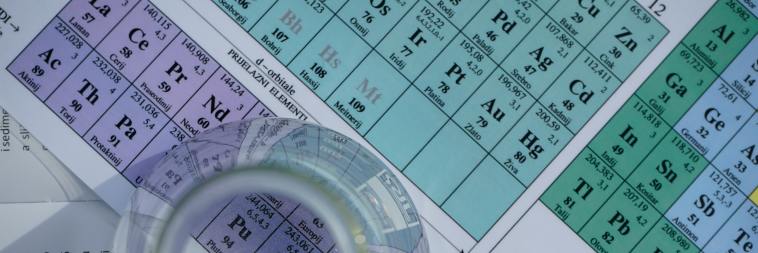What Are the Most Common Elements in the Universe?

In this article, we’ll delve into the fundamental building blocks of the cosmos and uncover the most common elements in the universe.

The universe is a vast expanse of mystery and wonder, composed of numerous elements – 118 to be precise, at the last count, and each has its own unique importance. However, some elements dominate the cosmic landscape, painting a fascinating picture of the universe’s composition. But which are the most common elements in the universe? Keep reading for all the answers!
What Are Elements?

Elements are the basic ingredients of matter, the essential components that give structure and diversity to everything we see in the universe. From the shimmering nebulae to the majestic galaxies, elements create a symphony of celestial wonders. But what exactly are they?
Elements are substances that cannot be broken down further by ordinary chemical means. We represent them on the periodic table, each with unique properties and atomic structures. There are 118 known elements, but only a handful dominate the universe.
How Are Elements Used?
The elements we can find throughout the cosmos serve many purposes. They fuel the stellar furnaces where fusion occurs, producing energy and light. Elements also play a pivotal role in forming planets, moons, and comets, sculpting the landscapes of distant worlds. Additionally, they are crucial for life as we know it, empowering the biochemistry of living organisms and allowing for complex molecular structures.
The Ten Most Common Elements Found Throughout the Universe
Before we delve into the identities of the ten most common elements in the universe, it’s essential to understand their pivotal role in the cosmos. These elements are not just numerous; they are literal building blocks, the very fabric of the cosmos, influencing everything from the formation of stars to the possibility of life itself.
So, let’s take a journey through the cosmic landscape as we explore the ten most common elements in the universe.
Hydrogen (H)
The true cosmic champion, hydrogen reigns supreme as the most abundant element in the vast expanse of the universe. Its ubiquitous presence permeates the very fabric of space, and its impact is tremendous.
Within the fiery cores of stars, hydrogen undergoes a remarkable transformation, unleashing an inferno of nuclear fusion that fuels the birth of stellar brilliance and illuminates the darkness of the cosmos with its radiant light. From the birth of galaxies to the formation of planetary systems, hydrogen shapes the celestial tapestry, reminding us of the remarkable beauty and complexity of the cosmos.
Helium (He)

Following closely behind hydrogen, helium gracefully dances alongside its celestial partner in the vast cosmic ballet. With its buoyant nature, this lightweight gas is a popular choice for party balloons! However, more importantly, it also serves as a crucial participant in the grand symphony of stellar nuclear reactions, where it contributes to the fusion process that powers the stars.
Oxygen (O)

Taking its rightful place as the third most abundant element in the universe is oxygen. Not only is it essential for sustaining life on Earth, but it also plays a significant role in forming other elements through stellar fusion.
During the life cycle of a star, oxygen is created through nuclear reactions in the stellar core, contributing to the synthesis of heavier elements that disperse into the cosmos upon the star’s explosive demise. This cosmic recycling of oxygen and other elements is a fundamental process that shapes the composition of galaxies and the building blocks of future stars and planets.
Carbon (C)
The fundamental building block of life as we know it, carbon is the backbone of organic compounds, playing a pivotal role in our existence. It’s a genuinely versatile element, capable of giving rise to an astonishing diversity of molecules, each contributing to the intricate and fascinating complexity of the natural world.
Nitrogen (N)
Nitrogen is undoubtedly abundant in our atmosphere, but it also has a significant presence in space. This versatile element contributes to the chemical makeup of stars, playing an essential role in the formation and evolution of galaxies.
Its presence in interstellar clouds facilitates the birth of new stars, as nitrogen-rich molecules serve as building blocks for creating complex organic compounds necessary for life to emerge. Thus, nitrogen’s influence extends beyond our planet, shaping the cosmic landscape and fostering the continuous evolution of celestial bodies.
Neon (Ne)

Neon is probably best known for its mesmerising, vibrant glow in eye-catching advertising signs. But it not only enchants us here on Earth – it also reveals its radiant presence in the vast expanse of space.
In the cosmic realm, neon shines brilliantly through cosmic rays, illuminating the celestial tapestry. Moreover, this remarkable element can be found in the form of plasma, creating stunning displays of light in various astronomical phenomena. Even within the atmospheres of certain celestial bodies, neon adds its unique touch, enhancing the mystical allure of the universe.
Magnesium (Mg)
Magnesium is essential for our bodies, but it also holds significance on a universal scale. Beyond its vital role in our physiology, magnesium plays a part in the synthesis of heavier elements within the fiery hearts of stars. As such, its presence in the cosmos links grandiose celestial processes and the elements that shape our existence.
Silicon (Si)
![]()
Widely available here on Earth, silicon plays a crucial part in the intricate formation of planetary systems. It contributes to the creation of diverse celestial bodies, ranging from solid rocky planets to moon-like satellites.
Its versatile nature and abundance make it an essential cosmic building block, weaving together the intricate wonders of the universe.
Sulphur (S)

With its distinctive smell and vibrant yellow appearance, sulphur adds a captivating touch to the chemical elements. It’s common in volcanic regions, where its presence is detectable through its unmistakable odour.
Sulphur plays a vital role in various biological processes and has a wide range of applications, from industrial to medicinal purposes. Its unique properties and versatility make it fascinating to explore and study.
Iron (Fe)

Last but certainly not least, iron holds a pivotal and captivating role in the vast expanse of the universe. From the fiery crucibles of massive stars, where iron forms in the immense pressure of stellar cores, to the iron-nickel cores that lie at the heart of celestial bodies, this extraordinary element forms the foundation for many cosmic phenomena.
Final Thoughts on the Most Common Elements in the Universe
From primordial hydrogen to majestic iron, each element has a story to tell. By understanding their prevalence and significance, we gain a deeper appreciation for the intricacies of our universe. So, let’s continue our celestial exploration, fueled by curiosity and a desire to uncover the mysteries that lie beyond.
For more astronomical adventures, check out our OSR Gift Pack, designed to enhance your cosmic journey. Happy stargazing!

